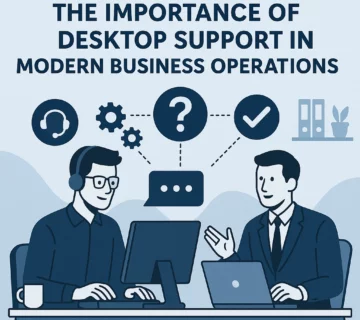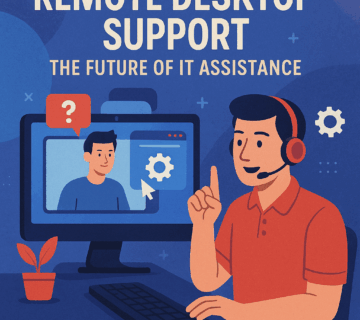The Evolving Role of Desktop Support in the Modern Workplace

In today’s high-tech age, employees’ productivity is as much a matter of the stability and reliability of their hardware as it is anything. Whether startup or multinational, organizations are discovering that their people can only be as great as the technology behind them. At the heart of this reality is an invisible but mission-critical service: desktop support. Far beyond “computer repair,” it has become a strategic business enabler, weaving together people, technology, and processes to keep businesses moving.
A Shift Away from Break-Fix to Preventative Service
Traditionally, desktop support was conceived of in a linear fashion: technicians stepped in when the PC of an employee crashed, the printer jammed, or the software failed to load. That “break-fix” approach worked in the past, but it was reactive and often disruptive. Time lost due to downtime became too costly for competitive companies. Today, proactive management has been the focus of efforts. Tools for monitoring, automation, and analytics are employed by teams to anticipate issues before they become serious. For instance, today’s fixes can warn of low storage on a laptop or a lack of a security patch so that the support team can correct the problem remotely before it interferes with the employee’s workday. This proactive attitude not only reduces downtime but also raises employee confidence in IT teams.
Enabling the Hybrid Workforce
The global transition to hybrid and remote offices has raised desktop support exponentially in terms of reach. Previously, technicians could simply walk over to an employee’s desk to resolve problems. Now, with employees distributed across cities, countries, and even continents, support teams have to deliver the same level of service without being present. This has come through the use of secure remote access software, cloud-based service desks, and collaboration software that enables fast issue resolution regardless of location. For the employees, this means less aggravation and a seamless experience. For the organizations, it ensures business continuity and productivity even if the workforce is scattered far and wide.
Security as a Top Priority
Because work devices are not part of highly controlled office networks, the necessity for cybersecurity desktop support has gone through the roof. Ransomware, phishing, and data breaches are no longer something for the future these are a reality daily. Support staff now have an important function to fill with enforcing security best practices, patching updates, and ensuring regulatory compliance at the endpoint. Active patching, multi-factor authentication, and real-time threat detection are now standard fare for support operations. Equally important, however, is the human element: support personnel often find themselves on the front lines of educating workers in safe practices, recognizing potential red flags, and keeping human error from sabotaging technological security mechanisms.
The Role of Automation and Artificial Intelligence
Automation and artificial intelligence (AI) are revolutionizing the desktop supports role in significant ways. Automated scripts can perform routine tasks like software installations or password resets without any human intervention. AI chatbots can provide employees immediate assistance for common issues, reducing wait times and enabling technicians to focus on complex problems.
Predictive analytics allow IT teams to identify trends such as recurring crashes on a particular software version—that might otherwise be invisible. By leveraging data, desktop teams can implement lasting fixes instead of repeatedly addressing the same symptoms. This creates not only efficiency, but also cost savings, since less effort is wasted on duplication of effort.
User Experience as a Differentiator
In the past, IT support was just gauged by how quickly it fixed technical problems. Now, organizations recognize that support interactions are part of the overall employee experience. A frustrating experience with support can lower morale, productivity, and even impact retention. Conversely, a simple and empathetic experience can improve engagement.
Support groups are adopting customer service principles communication, visibility, and follow-through to make workers feel valued. It has elevated the status of desktop support from a reactive, back-office function to a major driver of workplace satisfaction and productivity.
The Business Value of Robust Desktop Support
Beyond software’s self-evident purpose of getting things running, robust support delivers real business value:
Less Downtime – Fast remediation and predictive monitoring minimize lost time.
Enhanced Security – Endpoint protection on a regular basis eliminates the cost of costly breaches.
Scalability – Backup support arrangements can scale to address growing or dispersed workforces.
Cost Savings – Automation and self-service eliminate reliance on costly on-site visits.
Employee Retention – Seamless support experiences generate employee satisfaction and loyalty.
Companies that view support as a strategic asset instead of an expense center will be more competitive in markets.
Preparing for the Future
Later on, the function will evolve even more. The advent of Desktop as a Service (DaaS), in which entire computer environments are delivered through the cloud, should revolutionize the implementation and maintenance of workstations by businesses. Support personnel will have to care less about hardware devices and more about cloud environments, user permissions, and virtual infrastructure. Furthermore, the use of augmented reality (AR) tools might enable support technicians to “look” at what the user is looking at, with real-time guided troubleshooting. When combined with sophisticated AI, this could produce an almost imperceptible support experience.
Organizations that train their IT personnel, outfit them with current tools, and embed a culture of ongoing improvement will be well-positioned for these changes.
Conclusion
The desktop support role has developed far from only fixing technical problems. Today, it is an anticipatory, strategic, and people-oriented role that maintains productivity, improves security, and increases employee satisfaction. As work happens anywhere home, office, or on the move the need for robust support to enable technology, not disable it, is critical.
As businesses increasingly embrace hybrid work, automation, and cloud technologies, support’s role can only become more important. So much for the inaestheticity of a background job support will be a cornerstone of operational resilience and workplace success.




No comment